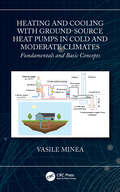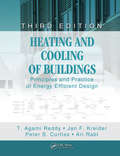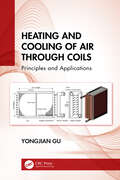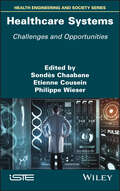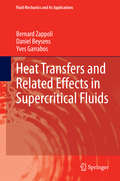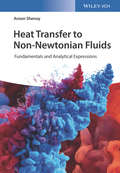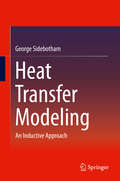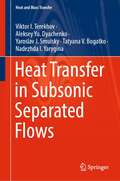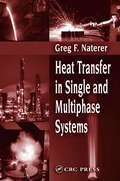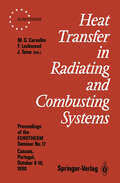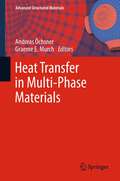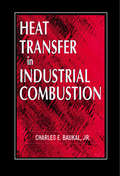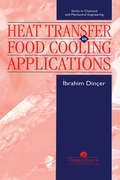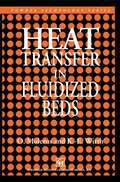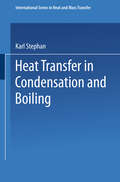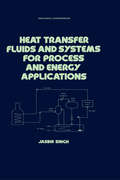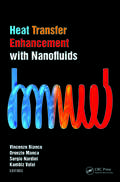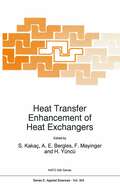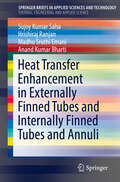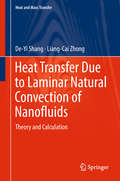- Table View
- List View
Heating and Cooling with Ground-Source Heat Pumps in Cold and Moderate Climates: Fundamentals and Basic Concepts
by Vasile MineaHeating and Cooling with Ground-Source Heat Pumps in Cold and Moderate Climates: Fundamentals and Basic Concepts covers fundamentals and design principles of vertical and horizontal indirect and direct expansion closed-loop, as well as ground and surface-water ground-source heat pump systems. It explains the thermodynamic aspects of mechanical and thermochemical compression cycles of geothermal heat pumps, and describes the energetic, economic, and environmental aspects associated with the use of ground-source heat pump systems for heating and cooling residential and commercial/institutional buildings in moderate and cold climates. Based on the author's more than 30 years of technical experience Focuses on ground-source heat pump technologies that can be successfully applied in moderate and cold climates Discusses technical aspects as well as the most common and uncommon application fields of basic system configurations This work is aimed at designers of HVAC systems, as well as geological, mechanical, and chemical engineers implementing environmentally-friendly heating and cooling technologies for buildings.
Heating and Cooling of Buildings: Principles and Practice of Energy Efficient Design, Third Edition (Mechanical and Aerospace Engineering Series)
by T. Agami Reddy Jan F. Kreider Peter S. Curtiss Ari RablHeating and Cooling of Buildings: Principles and Practice of Energy Efficient Design, Third Edition is structured to provide a rigorous and comprehensive technical foundation and coverage to all the various elements inherent in the design of energy efficient and green buildings. Along with numerous new and revised examples, design case studies, and homework problems, the third edition includes the HCB software along with its extensive website material, which contains a wealth of data to support design analysis and planning. Based around current codes and standards, the Third Edition explores the latest technologies that are central to design and operation of today’s buildings. It serves as an up-to-date technical resource for future designers, practitioners, and researchers wishing to acquire a firm scientific foundation for improving the design and performance of buildings and the comfort of their occupants. For engineering and architecture students in undergraduate/graduate classes, this comprehensive textbook:
Heating and Cooling of Buildings: Principles and Practice of Energy Efficient Design, Third Edition (Mechanical and Aerospace Engineering Series)
by T. Agami Reddy Jan F. Kreider Peter S. Curtiss Ari RablHeating and Cooling of Buildings: Principles and Practice of Energy Efficient Design, Third Edition is structured to provide a rigorous and comprehensive technical foundation and coverage to all the various elements inherent in the design of energy efficient and green buildings. Along with numerous new and revised examples, design case studies, and homework problems, the third edition includes the HCB software along with its extensive website material, which contains a wealth of data to support design analysis and planning. Based around current codes and standards, the Third Edition explores the latest technologies that are central to design and operation of today’s buildings. It serves as an up-to-date technical resource for future designers, practitioners, and researchers wishing to acquire a firm scientific foundation for improving the design and performance of buildings and the comfort of their occupants. For engineering and architecture students in undergraduate/graduate classes, this comprehensive textbook:
Heating and Cooling of Air Through Coils: Principles and Applications
by Yongjian GuHeating and Cooling of Air Through Coils combines theory and practice to cover the fundamentals in the processes of heating and cooling of air through coils and the key aspects in the psychrometric chart, the coil fluid piping systems, the coils, and the energy sources for the fluid in the coils. This book covers the integral elements that have a significant impact on the heating and cooling of air through coils, including the coil types, coil tube constructions and arrangements, and fluid flow characteristics in the coils. It also discusses sustainable and renewable energy sources used to heat and cool the fluid flowing in the piping system and the coils. In addition, the book covers the application of coils in central air-conditioning systems and split air-conditioning systems. Presents the fundamentals of heating and cooling of air through coils. Explains the psychrometric chart used for assessing the physical and thermodynamic properties of air in the heating and cooling processes. Covers numerous coil types and constructions. Discusses the key equipment used in the coil fluid piping systems that deliver hot water, steam, condensate, and chilled water to and from the coils. Considers various energy sources to the fluid in the coil piping system for heating and cooling, including solar heat energy, ocean thermal energy, and geothermal energy. This book will interest engineers and researchers involved in the design and operation of heat exchangers and HVAC systems. It can also be used as a textbook for undergraduate and graduate students majoring in relevant fields, such as thermal and fluids HVAC, and energy management.
Heating and Cooling of Air Through Coils: Principles and Applications
by Yongjian GuHeating and Cooling of Air Through Coils combines theory and practice to cover the fundamentals in the processes of heating and cooling of air through coils and the key aspects in the psychrometric chart, the coil fluid piping systems, the coils, and the energy sources for the fluid in the coils. This book covers the integral elements that have a significant impact on the heating and cooling of air through coils, including the coil types, coil tube constructions and arrangements, and fluid flow characteristics in the coils. It also discusses sustainable and renewable energy sources used to heat and cool the fluid flowing in the piping system and the coils. In addition, the book covers the application of coils in central air-conditioning systems and split air-conditioning systems. Presents the fundamentals of heating and cooling of air through coils. Explains the psychrometric chart used for assessing the physical and thermodynamic properties of air in the heating and cooling processes. Covers numerous coil types and constructions. Discusses the key equipment used in the coil fluid piping systems that deliver hot water, steam, condensate, and chilled water to and from the coils. Considers various energy sources to the fluid in the coil piping system for heating and cooling, including solar heat energy, ocean thermal energy, and geothermal energy. This book will interest engineers and researchers involved in the design and operation of heat exchangers and HVAC systems. It can also be used as a textbook for undergraduate and graduate students majoring in relevant fields, such as thermal and fluids HVAC, and energy management.
Heathcare Systems: Challenges and Opportunities
by Sondes Chaabane Etienne Cousein Philippe WieserThis book is centered around the development of agile, high-performing healthcare institutions that are well integrated into their environment. The aim is to take advantage of artificial intelligence, optimization and simulation methods to provide solutions to prevent, anticipate, monitor and follow public health developments in order to intervene at the right time, using tools and resources that are both appropriate and effective.The focus is on the people involved – the patients, as well as medical, technical and administrative staff – in an effort to provide an efficient healthcare and working environment that meets safety, quality and productivity requirements.Heathcare Systems has been written by healthcare professionals, researchers in science and technology as well as in the social sciences and humanities from various French-speaking countries. It explores the challenges and opportunities presented by digital technology in our practices, organizations and management techniques.
Heat Transfers and Related Effects in Supercritical Fluids (Fluid Mechanics and Its Applications #108)
by Bernard Zappoli Daniel Beysens Yves GarrabosThis book investigates the unique hydrodynamics and heat transfer problems that are encountered in the vicinity of the critical point of fluids. Emphasis is given on weightlessness conditions, gravity effects and thermovibrational phenomena. Near their critical point, fluids indeed obey universal behavior and become very compressible and expandable. Their comportment, when gravity effects are suppressed, becomes quite unusual.The problems that are treated in this book are of interest to students and researchers interested in the original behavior of near-critical fluids as well as to engineers that have to manage supercritical fluids. A special chapter is dedicated to the present knowledge of critical point phenomena. Specific data for many fluids are provided, ranging from cryogenics (hydrogen) to high temperature (water). Basic information in statistical mechanics, mathematics and measurement techniques is also included. The basic concepts of fluid mechanics are given for the non-specialists to be able to read the parts he is interested in. Asymptotic theory of heat transfer by thermoacoustic processes is provided with enough details for PhD students or researchers and engineers to begin in the field. Key spaces are described in details, with many comparisons between theory and experiments to illustrate the topics.
Heat Transfer to Non-Newtonian Fluids: Fundamentals and Analytical Expressions
by Aroon ShenoyThis book has been written with the idea of providing the fundamentals for those who are interested in the field of heat transfer to non-Newtonian fluids. It is well recognized that non-Newtonian fluids are encountered in a number of transport processes and estimation of the heat transfer characteristics in the presence of these fluids requires analysis of equations that are far more complex than those encountered for Newtonian fluids. A deliberate effort has been made to demonstrate the methods of simplification of the complex equations and to put forth analytical expressions for the various heat transfer situations in as vivid a manner as possible. The book covers a broad range of topics from forced, natural and mixed convection without and with porous media. Laminar as well as turbulent flow heat transfer to non-Newtonian fluids have been treated and the criterion for transition from laminar to turbulent flow for natural convection has been established. The heat transfer characteristics of non-Newtonian fluids from inelastic power-law fluids to viscoelastic second-order fluids and mildly elastic drag reducing fluids are covered. This book can serve the needs of undergraduates, graduates and industry personnel from the fields of chemical engineering, material science and engineering, mechanical engineering and polymer engineering.
Heat Transfer to Non-Newtonian Fluids: Fundamentals and Analytical Expressions
by Aroon ShenoyThis book has been written with the idea of providing the fundamentals for those who are interested in the field of heat transfer to non-Newtonian fluids. It is well recognized that non-Newtonian fluids are encountered in a number of transport processes and estimation of the heat transfer characteristics in the presence of these fluids requires analysis of equations that are far more complex than those encountered for Newtonian fluids. A deliberate effort has been made to demonstrate the methods of simplification of the complex equations and to put forth analytical expressions for the various heat transfer situations in as vivid a manner as possible. The book covers a broad range of topics from forced, natural and mixed convection without and with porous media. Laminar as well as turbulent flow heat transfer to non-Newtonian fluids have been treated and the criterion for transition from laminar to turbulent flow for natural convection has been established. The heat transfer characteristics of non-Newtonian fluids from inelastic power-law fluids to viscoelastic second-order fluids and mildly elastic drag reducing fluids are covered. This book can serve the needs of undergraduates, graduates and industry personnel from the fields of chemical engineering, material science and engineering, mechanical engineering and polymer engineering.
Heat Transfer Modeling: An Inductive Approach
by George SidebothamThis innovative text emphasizes a "less-is-more" approach to modeling complicated systems such as heat transfer by treating them first as "1-node lumped models" that yield simple closed-form solutions. The author develops numerical techniques for students to obtain more detail, but also trains them to use the techniques only when simpler approaches fail. Covering all essential methods offered in traditional texts, but with a different order, Professor Sidebotham stresses inductive thinking and problem solving as well as a constructive understanding of modern, computer-based practice. Readers learn to develop their own code in the context of the material, rather than just how to use packaged software, offering a deeper, intrinsic grasp behind models of heat transfer. Developed from over twenty-five years of lecture notes to teach students of mechanical and chemical engineering at The Cooper Union for the Advancement of Science and Art, the book is ideal for students and practitioners across engineering disciplines seeking a solid understanding of heat transfer.This book also:· Adopts a novel inductive pedagogy where commonly understood examples are introduced early and theory is developed to explain and predict readily recognized phenomena · Introduces new techniques as needed to address specific problems, in contrast to traditional texts’ use of a deductive approach, where abstract general principles lead to specific examples· Elucidates readers’ understanding of the "heat transfer takes time" idea—transient analysis applications are introduced first and steady-state methods are shown to be a limiting case of those applications · Focuses on basic numerical methods rather than analytical methods of solving partial differential equations, largely obsolete in light of modern computer power· Maximizes readers’ insights to heat transfer modeling by framing theory as an engineering design tool, not as a pure science, as has been done in traditional textbooks· Integrates practical use of spreadsheets for calculations and provides many tips for their use throughout the text examples
Heat Transfer in Subsonic Separated Flows (Heat and Mass Transfer)
by Viktor I. Terekhov Aleksey Yu. Dyachenko Yaroslav J. Smulsky Tatyana V. Bogatko Nadezhda I. YaryginaThis book presents the results of scientific research performed over the past two decades by the authors. The book discusses some issues of separated laminar flows that are of great practical interest for the development of new technologies using microchannel flows, where separation zones can form. Of particular interest is the complex mechanism of flow separation with superimposed high external turbulence. The challenges of finding the optimal location for the cavities and fins on heat exchange surfaces are also considered. This is an important fundamental and practical problem when creating new schemes of efficient heat exchangers in various power plants. A wide class of problems of turbulent flow in tubes with flow separation is considered. These data will be useful in engineering estimates of the thermal–hydraulic efficiency of various heat transfer intensifiers. This book focuses on the analysis of thermal characteristics of separated flows, as well as the possibility of controlling the intensity of heat exchange processes, from the point of view of both their intensification and their suppression.
Heat Transfer in Single and Multiphase Systems
by Greg F. NatererExtensively revised and thoroughly updated, this popular text de-emphasizes high level mathematics in favor of effective, accurate modeling. Real-world examples amplify the theory and show how to use derived equations to model physical problems. Exercises that parallel the examples build readers' confidence and prepare them to confront the more com
Heat Transfer in Radiating and Combusting Systems: Proceedings of EUROTHERM Seminar No. 17, 8–10 October 1990, Cascais, Portugal (EUROTHERM Seminars #17)
by Maria G. Carvalho Fred C. Lockwood Jean TaineThis volume contains the selected papers presented at the EUROTHERM SEMINAR No. 17 - Heat Transfer in Radiating and Combusting Systems held at Cascais from October 8th- 10th, 1990. The EUROTHERM COMMITTEE was created by representatives of the member countries of the European Communities for the organization and coordination of European Scientific events in the field of thermal sciences and their applications. The book is focused on the integration of the heat transfer and combustion. These two subjects have traditionally been considered separate disciplines. In reality, the two are closely interwoven. The central purpose of the book is to generate an effective cross fertilisation of the two at both the fundamental and applied levels. The book reports on: mathematical simulations of heat transfer in reacting systems, new measurements of and measurement techniques for the radiation properties of the intervening medium, and data and theoretical analyses which clarify the physical nature of the complex interactions between the radiation/convection heat transfer processes and the combustion and turbulence of real reacting flows.
Heat Transfer in Multi-Phase Materials (Advanced Structured Materials #2)
by Andreas Öchsner and Graeme E. E. MurchThis book provides a profound understanding, which physical processes and mechanisms cause the heat transfer in composite and cellular materials. It shows models for all important classes of composite materials and introduces into the latest advances.In three parts, the book covers Composite Materials (Part A), Porous and Cellular Materials (Part B) and the appearance of a conjoint solid phase and fluid aggregate (Part C).
Heat Transfer in Industrial Combustion
by Jr., Charles BaukalIndustry relies heavily on the combustion process. The already high demand for energy, primarily from combustion, is expected to continue to rapidly increase. Yet, the information is scattered and incomplete, with very little attention paid to the overall combustion system. Designed for practicing engineers, Heat Transfer in Industrial Combustion e
Heat Transfer In Food Cooling Applications
by Ibrahim DincerThis comprehensive book is a valuable and readable reference text and source for anyone who wishes to learn about food cooling applications and methods of analysis of the heat transfer during these applications.
Heat Transfer In Food Cooling Applications
by Ibrahim DincerThis comprehensive book is a valuable and readable reference text and source for anyone who wishes to learn about food cooling applications and methods of analysis of the heat transfer during these applications.
Heat Transfer in Condensation and Boiling (International Series in Heat and Mass Transfer)
by Karl StephanI welcome the opportunity to have my book translated, because of the great emphasis on two-phase flow and heat transfer in the English-speaking world, as related to research, university education, and industrial practice. The 1988 Springer-Verlag edition of "Warmeiibergang beim Kondensieren und beim Sieden" has been enlarged to include additional material on falling film evaporation (Chapter 12) and pressure drop in two-phase flow (Chapter 13). Minor errors in the original text have also been corrected. I would like to express my sincere appreciation to Professor Green, Asso ciate Professor of German at Rensselaer, for his excellent translation and co operation. My thanks go also to Professor Bergles for his close attention to technical and linguistic details. He carefully read the typescript and made many comments and suggestions that helped to improve the manuscript. I hope that the English edition will meet with' a favorable reception and contribute to better understanding and to progress in the field of heat transfer in condensation and boiling. February 1992 K. Stephan Preface to the German-Language Edition This book is a continuation of the series "Heat and Mass Transfer" edited by U. Grigull, in which three volumes have already been published. Its aim is to acquaint students and practicing engineers with heat transfer during condensa tion and boiling, and is intended primarily for students and engineers in mechanical, chemical, electrical, and industrial processing engineering.
Heat Transfer Fluids and Systems for Process and Energy Applications
by Jasbir SinghThis book presents the basic principles and engineering data governing the process design of indirect heat transfer fluids and systems. It focuses on the selection of systems based on common engineering criteria such as reliability and cost, and particularly on energy conservation and safety.
Heat Transfer Fluids and Systems for Process and Energy Applications
by Jasbir SinghThis book presents the basic principles and engineering data governing the process design of indirect heat transfer fluids and systems. It focuses on the selection of systems based on common engineering criteria such as reliability and cost, and particularly on energy conservation and safety.
Heat Transfer Enhancement with Nanofluids
by Vincenzo Bianco Oronzio Manca Sergio Nardini Kambiz VafaiNanofluids are gaining the attention of scientists and researchers around the world. This new category of heat transfer medium improves the thermal conductivity of fluid by suspending small solid particles within it and offers the possibility of increased heat transfer in a variety of applications. Bringing together expert contributions from
Heat Transfer Enhancement of Heat Exchangers (NATO Science Series E: #355)
by Sadik Kakaç Arthur E. Bergles F. Mayinger Hafit YüncüHeat transfer enhancement in single-phase and two-phase flow heat exchangers in important in such industrial applications as power generating plant, process and chemical industry, heating, ventilation, air conditioning and refrigeration systems, and the cooling of electronic equipment. Energy savings are of primary importance in the design of such systems, leading to more efficient, environmentally friendly devices. This book provides invaluable information for such purposes.
Heat Transfer Enhancement in Externally Finned Tubes and Internally Finned Tubes and Annuli (SpringerBriefs in Applied Sciences and Technology)
by Sujoy Kumar Saha Hrishiraj Ranjan Madhu Sruthi Emani Anand Kumar BhartiThis Brief deals with externally finned tubes, their geometric parameters, Reynolds number, dimensionless variables, friction factor, plain plate fins on round tubes, the effect of fin spacing, correlations, pain individually finned tubes, circular fins with staggered tubes, low integral fin tubes, wavy fin, enhanced plate fin geometries with round tubes, Offset Strip Fins, convex louver fins, louvered fin, perforated fin, mesh fin, vortex generator, enhanced circular fin geometries, spine or segmented fin, wire loop fin, flat extruded tubes with internal membranes, plate and fin automotive radiators, performance comparison, numerical simulation, advanced fin geometries, hydrophilic coatings, internally finned tubes and annuli, spirally fluted and indented tube, advanced internal fin geometries, and finned annuli. The book is ideal for professionals and researchers dealing with thermal management in devices.
Heat Transfer Due to Laminar Natural Convection of Nanofluids: Theory and Calculation (Heat and Mass Transfer)
by De-Yi Shang Liang-Cai ZhongThis book presents a theoretical study of heat transfer due to laminar natural convection of nanofluids, using Al2O3-water nanofluid as an example. An innovative method of similarity transformation of velocity fields on laminar boundary layers is applied for the development of a mathematical governing model of natural convection with actual nanofluids, and a novel model of the nanofluid's variable thermophysical properties is derived by a mathematical analysis based on the developed model of variable physical properties of fluids combined with the model of the nanofluid's thermal conductivity and viscosity. Based on these, the physical property factors of nanofluids are produced, which leads to a simultaneous solution for deep investigations of hydrodynamics and heat transfer of nanofluid's natural convection.The book also proposes novel predictive formulae for the evaluation of heat transfer of Al2O3-water nanofluid’s natural convection. The formulae have reliable theoretical and practical value because they are developed by rigorous theoretical analysis of heat transfer combined with full consideration of the effects of the temperature-dependent physical properties of nanofluids and the nanoparticle shape factor and concentration, as well as variations of fluid boundary temperatures. The conversion factors proposed help to turn the heat transfer coefficient and rate of fluid natural convection into those of nanofluid natural convection. Furthermore, several calculation examples are provided to demonstrate the heat transfer application of the proposed predictive formulae.
